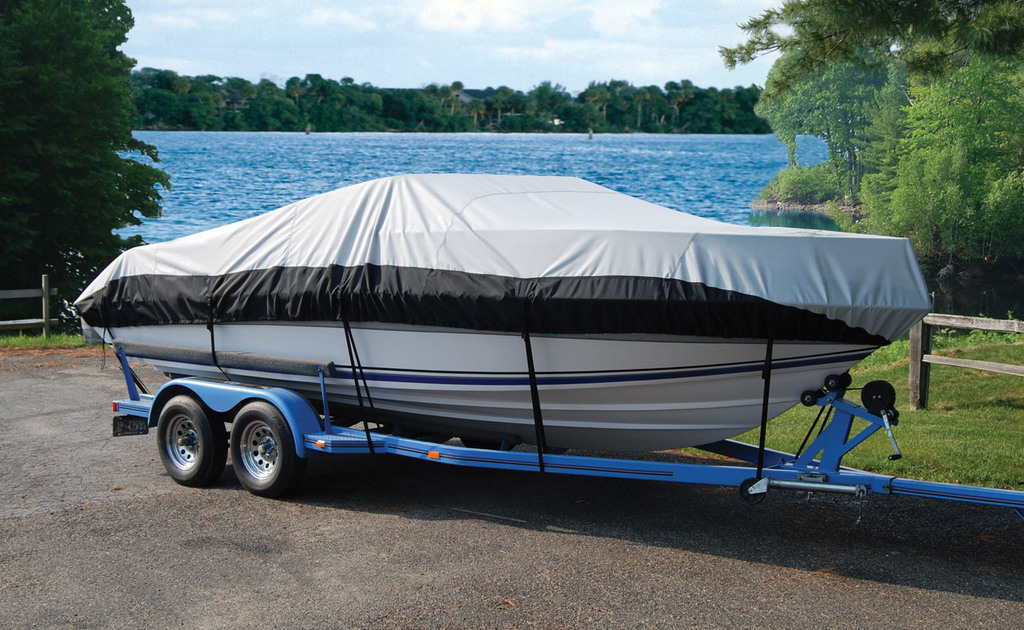Keeping your boat cover clean is not just about making it look good. It is one of the most effective ways to protect your boat from weather, sun exposure, mildew, and general wear.
Whether your cover is made of canvas or synthetic fabric, regular cleaning helps it last longer and function properly. According to USDA Forest Products Lab research, outdoor fabrics that are well maintained can last significantly longer than neglected ones.
This guide will walk you through the best way to clean your boat cover without damaging it or wasting your time.
Prevents sun damage and fading of your boat's surfaces
Protects against rain, snow, and harsh weather conditions
Keeps leaves, dirt, and debris off your boat
Start by laying your cover flat on a clean surface like a driveway, deck, or tarp. Look closely for any rips, worn areas, or signs of mold.
Make any repairs before cleaning, since scrubbing a damaged cover can make things worse. It is also a good time to identify any stains that may need extra attention.
Patch small holes and reinforce weak seams before washing to prevent further damage during the cleaning process.
Before using any water, remove loose debris using a vacuum or soft-bristle brush. Leaves, sand, pollen, and dust often settle in seams and corners.
Pro Tip: Getting rid of this debris beforehand helps prevent scratches and allows for a more effective clean.
Ideal for removing fine particles, dust, and small debris from fabric surface and seams
Perfect for loosening stuck debris without damaging the fabric fibers
Often collect in corners and folds
Can be abrasive if not removed first
Creates stains when mixed with water
Remove carefully to avoid smearing
A mild soap mixed with water is often all you need. You can also use a marine fabric cleaner if your cover is heavily soiled.
Avoid harsh chemicals or bleach, especially on canvas. The U.S. Naval Academy's canvas care guide advises against bleach because it weakens fabric fibers and causes fading.
Apply the solution to the fabric with a sponge or soft brush, gently scrubbing small sections at a time. Use circular motions and avoid scrubbing too hard.
For mildew, the University of Florida IFAS Extension offers safe cleaning advice that works well for boat fabrics too.
Use a garden hose with light pressure to rinse the cover. Make sure you wash off all soap from every section. Leftover residue attracts dirt and can weaken waterproofing.
Critical: Be especially thorough along seams and folds where soap tends to hide.

Allow the cover to dry completely in a shaded or sunny, well-ventilated area. Never fold or store the cover while it is still damp, as this encourages mildew.
Humid Areas: Consider using a fan or drying rack to speed things up.
After the cover has dried, it may be a good idea to apply a water-repellent spray to keep the material protected. This is especially helpful for canvas covers, which lose repellency over time.
The National Park Service offers preservation guidance for outdoor fabrics and explains how water repellents can help preserve textiles exposed to the elements.
Ensure cover is completely clean and dry
Apply treatment evenly following product instructions
Allow to cure according to label instructions
Creates excellent water repellency
Additional protection from sun damage
Prolongs cover lifespan significantly
When you are not using the boat cover, store it in a cool, dry place. Avoid folding it if it is dirty or damp.
If the cover stays installed on the boat, keep it taut so that water does not pool on top. Sagging covers lead to moisture retention, mold growth, and permanent creases.
Some boat covers need professional attention, especially if they are oversized, delicate, or heavily soiled. A pro can deep clean the material without causing damage.
If your cover is vintage, expensive, or suffering from repeated mildew growth, it might be worth the cost to have it professionally treated.
Even the best maintenance cannot make a boat cover last forever. If your cover has tears that cannot be repaired, sun-faded fabric, or water that soaks through instead of beads up, it might be time for a new one.
Final Warning: Persistent mildew, even after cleaning, is another sign you may need to replace it.

For replacement tips, check out comprehensive buying guides that can help you choose the right cover for your specific boat type and usage patterns.
Cleaning your boat cover is a simple but important step in protecting your vessel. With a little care and the right approach, you can extend the life of your cover and keep it looking and working like new.
Do not wait for stains or mildew to settle in. Make cleaning part of your seasonal routine and apply water repellent as needed.
Regular Maintenance
Seasonal cleaning routine
Protection
Extends cover lifespan
Savings
Prevents costly replacements
By following these best practices, your boat cover will last longer, perform better, and save you money in the long run.
Check for damage and identify stains
Vacuum and brush away loose dirt
Use mild soap, avoid bleach
Thorough rinse, check seams
Complete drying before storage
Apply water repellent treatment
Frequency: Clean your boat cover at least twice per season, or immediately after storms and heavy use periods.
Welcome to Sunrise Marine Detailing, where we turn the tide on wear and tear to restore the magnificence of your maritime treasures.